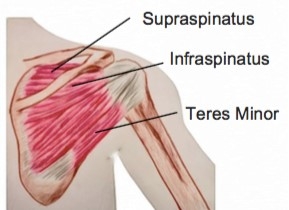
Rotator Cuff Tears
What Is the rotator cuff?
The rotator cuff is a group of four small muscles that surround the shoulder joint. Their tendons attach to the humerus, close to the joint line and act as a cuff that provides support and control to the shoulder. They also play a primary role in creating rotational movements of the shoulder.
Rotator cuff tears are common injuries and can occur in any of the four muscles. This usually occurs at their weakest point, the junction between the muscle and tendinous tissue. These tears are common in racket and throwing sports and are one of the leading causes of shoulder pain. The prevalence of rotator cuff tears increases as we age due to age related degenerative changes in the tissues.
What are the symptoms?
Many people have rotator cuff tears with no symptoms at all, and are unaware of the injury. However, for others, these tears can be very painful and lead to difficulty moving the shoulder, particularly with overhead activities. They may find their range of movement is restricted and the arm feels weak. They often experience pain that radiates down to the arm and pain at night, which can cause sleep disturbances.
It is interesting to note that the size of a tear is not necessarily related to the amount of pain and dysfunction experienced. Small tears sometimes create large problems and large tears can even go unnoticed.
What are the causes?
Movements that create a rapid twisting motion or overstretching of the shoulder often cause rotator cuff tears. The most common mechanism of injury is a fall onto an outstretched hand. These tears can be acute or chronic, developing over a period of time or related to degenerative changes, where tendon tissue is damaged by everyday activities due to reduced strength and elasticity.
Other causes of rotator cuff tears include overuse, lifting or carrying heavy objects and repetitive overhead activities. Poor biomechanics can cause weakening of the shoulder’s tendons with insufficient blood supply to the rotator cuff over a long period of time. This can leave the tendon more susceptible to injury as is a significant contributing factor to the development of tears and the outcomes of recovery.
How can physiotherapy help?
The primary objectives of physiotherapy treatment are to reduce pain, increase range of motion and strength and improve shoulder function. Your physiotherapist will work with you to help set goals assist to reach them with a targeted rehabilitation program, manual therapy and education on how to achieve the most from your recovery.
While severe tears are often repaired surgically, research is increasingly showing that even in severe tears, a comprehensive rehabilitation program under a physiotherapist leads to similar outcomes to surgery. For this reason, a conservative approach guided by a physiotherapist is often recommended to patients as the first option for treatment. The exact time frame of treatment and recovery will vary from person to person and is affected by a variety of factors including if surgical repair was chosen, the severity of the injury and function prior to injury.
None of the information in this newsletter is a replacement for proper medical advice. Always see a medical professional for advice on your individual injury.
If you require professional advice or treatment, please see our range of treatment options, or book an appointment online. Physio Direct has many clinics located throughout New Zealand, with no GP referral required to make an appointment.
Physio Direct is ACC accredited so you can come to us directly to get an injury registered with ACC without having to go to your GP first, followed by an assessment, treatment and follow up review, to ensure correct care and recovery. Physio Direct can also refer you directly for Cortisone injections, X-Rays and Ultra Sound Scans and on to Specialists if needed.
Please feel free to print out these news letters and put the in the staffroom and hand them out to your team. Understanding more about injuries, gives people the power to prevent an injury from occurring in the first place. Prevention and education is the key!
